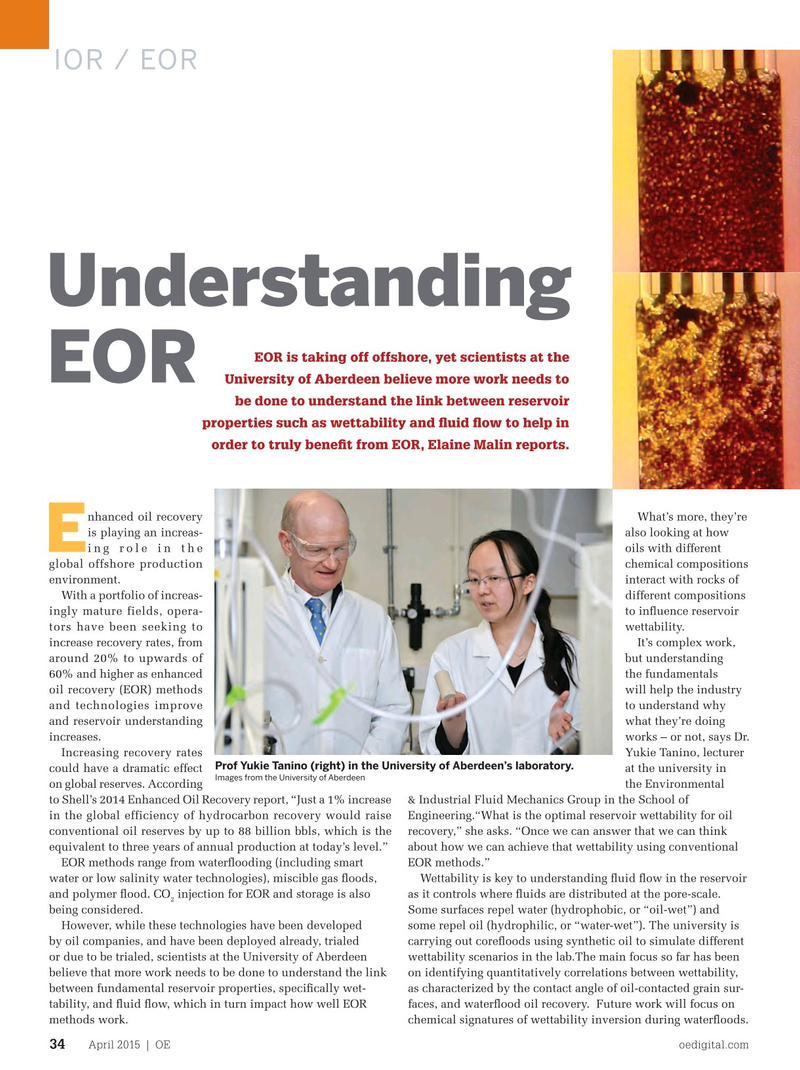
Page 32: of Offshore Engineer Magazine (Apr/May 2015)
Read this page in Pdf, Flash or Html5 edition of Apr/May 2015 Offshore Engineer Magazine
IOR / EOR
Understanding
EOR is taking off offshore, yet scientists at the
EOR
University of Aberdeen believe more work needs to be done to understand the link between reservoir properties such as wettability and fuid fow to help in order to truly beneft from EOR, Elaine Malin reports.
What’s more, they’re nhanced oil recovery A further development of the research program at the univer- also looking at how is playing an increas- sity has seen Tanino and her colleague Dr. Stephen Bowden in
E oils with different ing role in the the Department of Geology and Petroleum Geology assembling chemical compositions global offshore production mm-scale models of reservoirs in microfuidic chips. This interact with rocks of environment. approach has two main benefts. First, it provides a petro- different compositions With a portfolio of increas- graphic perspective (a geologist’s view through a microscope) of to infuence reservoir ingly mature fields, opera- what’s happening. Second, the small scales of the model reser- wettability. tors have been seeking to voir speeds up experiments, permitting a much bigger range of increase recovery rates, from It’s complex work, around 20% to upwards of but understanding 60% and higher as enhanced the fundamentals oil recovery (EOR) methods will help the industry and technologies improve to understand why and reservoir understanding what they’re doing increases. works – or not, says Dr.
Increasing recovery rates Yukie Tanino, lecturer
Prof Yukie Tanino (right) in the University of Aberdeen’s laboratory. could have a dramatic effect at the university in
Images from the University of Aberdeen on global reserves. According the Environmental to Shell’s 2014 Enhanced Oil Recovery report, “Just a 1% increase & Industrial Fluid Mechanics Group in the School of in the global efficiency of hydrocarbon recovery would raise Engineering.“What is the optimal reservoir wettability for oil conventional oil reserves by up to 88 billion bbls, which is the recovery,” she asks. “Once we can answer that we can think equivalent to three years of annual production at today’s level.” about how we can achieve that wettability using conventional
EOR methods range from waterfooding (including smart EOR methods.” water or low salinity water technologies), miscible gas foods, Wettability is key to understanding fuid fow in the reservoir and polymer food. CO injection for EOR and storage is also as it controls where fuids are distributed at the pore-scale. 2 being considered. Some surfaces repel water (hydrophobic, or “oil-wet”) and
However, while these technologies have been developed some repel oil (hydrophilic, or “water-wet”). The university is by oil companies, and have been deployed already, trialed carrying out corefoods using synthetic oil to simulate different or due to be trialed, scientists at the University of Aberdeen wettability scenarios in the lab.The main focus so far has been believe that more work needs to be done to understand the link on identifying quantitatively correlations between wettability, between fundamental reservoir properties, specifcally wet- as characterized by the contact angle of oil-contacted grain sur- tability, and fuid fow, which in turn impact how well EOR faces, and waterfood oil recovery. Future work will focus on methods work. chemical signatures of wettability inversion during waterfoods.
April 2015 | OE oedigital.com 34 034-OE0415_Feat1_Aberdeen U.indd 34 3/23/15 2:24 PM

 31
31

 33
33